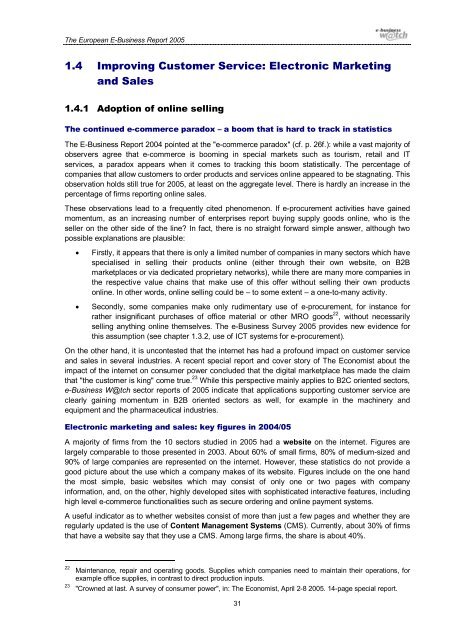The European e-Business Report The European e ... - empirica
The European e-Business Report The European e ... - empirica
The European e-Business Report The European e ... - empirica
You also want an ePaper? Increase the reach of your titles
YUMPU automatically turns print PDFs into web optimized ePapers that Google loves.
<strong>The</strong> <strong>European</strong> E-<strong>Business</strong> <strong>Report</strong> 2005<br />
1.4 Improving Customer Service: Electronic Marketing<br />
and Sales<br />
1.4.1 Adoption of online selling<br />
<strong>The</strong> continued e-commerce paradox – a boom that is hard to track in statistics<br />
<strong>The</strong> E-<strong>Business</strong> <strong>Report</strong> 2004 pointed at the "e-commerce paradox" (cf. p. 26f.): while a vast majority of<br />
observers agree that e-commerce is booming in special markets such as tourism, retail and IT<br />
services, a paradox appears when it comes to tracking this boom statistically. <strong>The</strong> percentage of<br />
companies that allow customers to order products and services online appeared to be stagnating. This<br />
observation holds still true for 2005, at least on the aggregate level. <strong>The</strong>re is hardly an increase in the<br />
percentage of firms reporting online sales.<br />
<strong>The</strong>se observations lead to a frequently cited phenomenon. If e-procurement activities have gained<br />
momentum, as an increasing number of enterprises report buying supply goods online, who is the<br />
seller on the other side of the line? In fact, there is no straight forward simple answer, although two<br />
possible explanations are plausible:<br />
• Firstly, it appears that there is only a limited number of companies in many sectors which have<br />
specialised in selling their products online (either through their own website, on B2B<br />
marketplaces or via dedicated proprietary networks), while there are many more companies in<br />
the respective value chains that make use of this offer without selling their own products<br />
online. In other words, online selling could be – to some extent – a one-to-many activity.<br />
• Secondly, some companies make only rudimentary use of e-procurement, for instance for<br />
rather insignificant purchases of office material or other MRO goods 22 , without necessarily<br />
selling anything online themselves. <strong>The</strong> e-<strong>Business</strong> Survey 2005 provides new evidence for<br />
this assumption (see chapter 1.3.2, use of ICT systems for e-procurement).<br />
On the other hand, it is uncontested that the internet has had a profound impact on customer service<br />
and sales in several industries. A recent special report and cover story of <strong>The</strong> Economist about the<br />
impact of the internet on consumer power concluded that the digital marketplace has made the claim<br />
that "the customer is king" come true. 23 While this perspective mainly applies to B2C oriented sectors,<br />
e-<strong>Business</strong> W@tch sector reports of 2005 indicate that applications supporting customer service are<br />
clearly gaining momentum in B2B oriented sectors as well, for example in the machinery and<br />
equipment and the pharmaceutical industries.<br />
Electronic marketing and sales: key figures in 2004/05<br />
A majority of firms from the 10 sectors studied in 2005 had a website on the internet. Figures are<br />
largely comparable to those presented in 2003. About 60% of small firms, 80% of medium-sized and<br />
90% of large companies are represented on the internet. However, these statistics do not provide a<br />
good picture about the use which a company makes of its website. Figures include on the one hand<br />
the most simple, basic websites which may consist of only one or two pages with company<br />
information, and, on the other, highly developed sites with sophisticated interactive features, including<br />
high level e-commerce functionalities such as secure ordering and online payment systems.<br />
A useful indicator as to whether websites consist of more than just a few pages and whether they are<br />
regularly updated is the use of Content Management Systems (CMS). Currently, about 30% of firms<br />
that have a website say that they use a CMS. Among large firms, the share is about 40%.<br />
22<br />
23<br />
Maintenance, repair and operating goods. Supplies which companies need to maintain their operations, for<br />
example office supplies, in contrast to direct production inputs.<br />
"Crowned at last. A survey of consumer power", in: <strong>The</strong> Economist, April 2-8 2005. 14-page special report.<br />
31

















